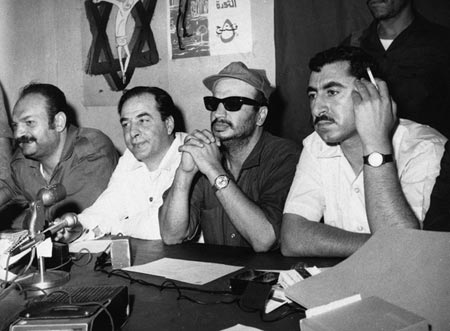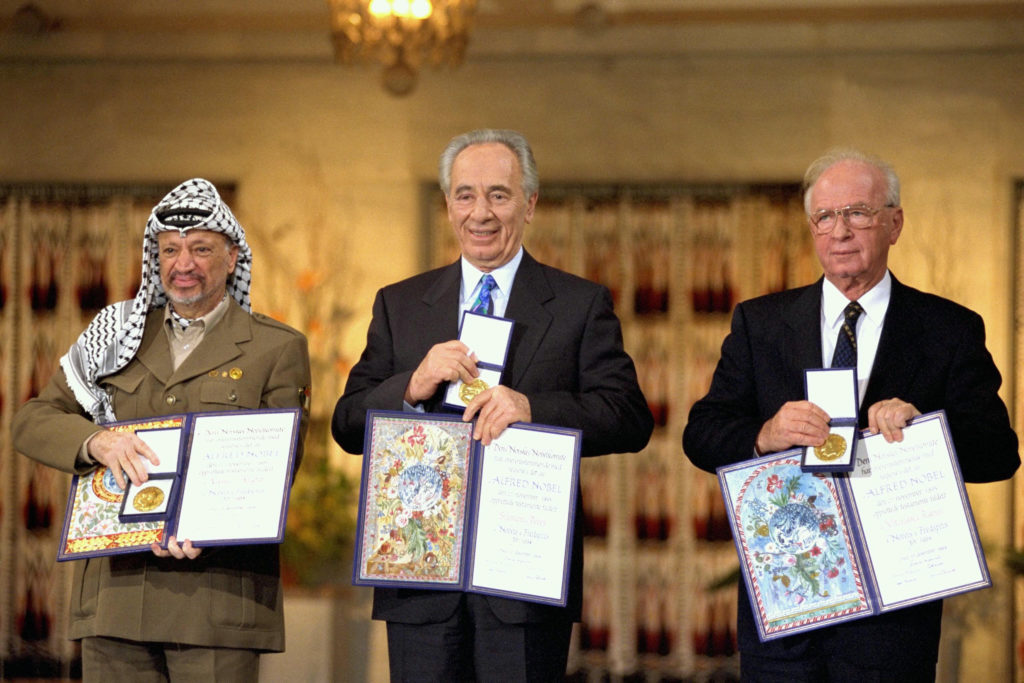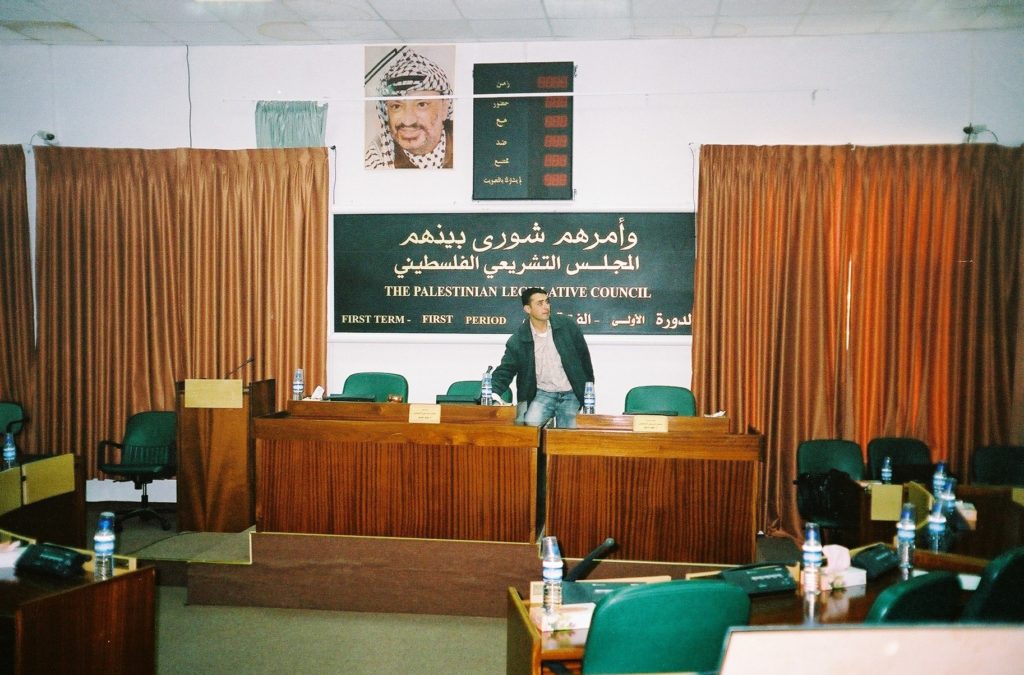Palestinian Politics
How do Palestinian politics work?
Part of: Hey Alma’s Guide to the Israeli-Palestinian ConflictWho is in charge of the Palestinian territories? Is it one person or party? Are there elections? What does the Palestinian political spectrum look like?
Lots of questions. Let’s start with…
Palestinian Liberation Organization
In 1964, at the first meeting of the Palestinian National Council (PNC), the Palestinian Liberation Organization, or PLO, formed. (Earlier that year, at the first Arab League summit in Cairo, Arab leaders called for the creation of an organization to represent Palestinians.) According to Palestinian scholar Rashid Khalidi, “The PLO was founded in response to a number of factors, including the growing salience of the Palestine question in inter‐Arab politics, the increasing friction between the Arab states and Israel over water diversion projects and other issues, and the growth of underground, independent Palestinian nationalist activity, which Arab governments, notably that of Egypt, wanted to preempt.”
The PLO became an umbrella organization for Palestinian groups; at its founding, it stated its goal was the “liberation of Palestine” via armed struggle. The Palestine National Charter of 1964, also called the PLO Charter, reads:
We, the Palestinian Arab people, who faced the forces of evil, injustice and aggression, against whom the forces of international Zionism and colonialism conspire and worked to displace it, dispossess it from its homeland and property, abused what is holy in it and who in spite of all this refused to weaken or submit.

From the start of the PLO, it was a government-in-exile. First, it was headquartered in Jordan until Black September, then Lebanon, then Tunis, until it arrived to Ramallah in 1993 following the Oslo Accords. In 1994, the Palestinian Authority was established.
Is the PLO a terrorist organization?
The world at large does not consider the PLO a terrorist organization (the way it does Hamas, for example), but things are still a little complicated. In 1993, then PLO leader Yasser Arafat renounced terrorism and acknowledged Israel’s right to exist, yet many Israelis on the right saw that statement as merely lip service, given the fact that the PLO had carried out terrorist attacks in the past. There were factions and/or affiliates of the PLO that continued to engage in terrorist acts after that denouncement.
As My Jewish Learning points out, “During the 1970s, the PLO became virtually a synonym for terrorism — a strategy that, ironically, increasingly won the Palestinian cause sympathy in the international arena. The PLO invented airplane hijackings and carried out many of them, and its constituent groups were responsible for a large number of other terrorist attacks, including the assassination of Jordan’s prime minister in Cairo in 1971 and the murder of 11 Israeli athletes at the Olympic Games in Munich in 1972.”
Who led the PLO?
There have been four leaders of the PLO:
- Ahmad Shuqayrī, a lawyer and ally of Egyptian president Gamal Abdel Nasser, from 1964 until his resignation in 1967.
- Yahia Hammuda from 1967 to 1969.
- Yasser Arafat from 1969 until his death in 2004.
- Mahmoud Abbas from 2004 to present.
Arafat is the big one here — he defined the PLO for decades, leading the Palestinian resistance movement from Jordan, then Lebanon, then Tunisia, until he returned to Palestinian territory in 1994. During the majority of this time, he was widely considered a terrorist leader, directing numerous violent acts against Israeli citizens.

So what’s the Palestinian Authority (PA)?
The PA was formed in 1993, by the Oslo Accords, to manage and control the areas that Israel withdrew from. This was supposed to keep going until the permanent status agreement with Israel; the idea was the PA would run Palestinian affairs until a future Palestinian state was established. The PLO approved the accords, which entailed the creation of the PA.
As part of the PA, there’s the Palestinian Legislative Council (PLC). You can think of the PLC sort of as the Palestinian parliament. The PLC members are elected by Palestinians living in the West Bank and Gaza.

This is different than the PLO’s Palestinian National Council (PNC), a parliamentary body that is elected by Palestinians everywhere except for Palestinian citizens of Israel.
Basically, there are still a bunch of disparate Palestinian organizations with their own individual structures.
But wait, I thought Arafat led a different group?
He did! It’s called Fatah, and it’s a secular/nationalist group founded in the late 1950s by Arafat and other Palestinian nationalists. They pre-date the PLO, but once the PLO was formed, they became the most powerful faction within the organization.
As NPR points out, “Despite its violent past, Fatah is now seen as the more moderate Palestinian party. While the group’s constitution also calls for the destruction of Israel, the group falls under the PLO, which has renounced terrorism. Fatah’s leadership of the Palestinian Authority was seen as corrupt and inept by many Palestinians.”
So, if you’re still with us: The PLO controls the PA, but Fatah is the majority faction of the PNC (in the PLO) and PLC (in the PA), so they’re the party in power. Got it?

Basically, this fractured government means Palestinian political bodies still kind of function independently because they never became a traditional state with a unified leadership structure.
How does Fatah get elected?
Well, staring in 1994, after the PA was formed, elections were held in Palestinian Autonomous areas, under the framework of the Oslo Accords. In the 1996 general election, Fatah won 55 of the 88 seats, cementing its power.
So, Fatah controls the West Bank and Gaza Strip?
It did, until 2006.
What happened in 2006?
Let’s back up a sec.
Some history to situate us: In 2004, Yasser Arafat died, and in 2005, Israel withdrew from the Gaza Strip. It wasn’t what you’d call a smooth disengagement. Following that, tensions between Fatah and Hamas — an organization we somehow have not discussed yet, but we’ll get to them soon, we promise — began to rise.
In the January 2006 legislative elections, Hamas won 74 of the 132 seats, and Fatah only won 45 seats. Hamas leader Ismail Haniya formed a unity government — a power sharing deal with Fatah — but it didn’t go well. There was violence between Hamas and Fatah, leading to what some call the “Palestinian Civil War.”
After the sporadic violence, Mahmoud Abbas (who was president) dissolved the government in early 2007.

Haniya still says he is prime minister of the PA. When Hamas pushed Fatah out of Gaza, Hamas became the de facto leader of Gaza (it has ever since) and Fatah remains in charge of the PA in the West Bank.
Wait. What is Hamas?!
Hamas is an acronym for Harakat al-Muqawamah al-Islamiyya, or Islamic Resistance Movement.

Sheikh Ahmad Yasin founded Hamas in 1987 as an offshoot of the Muslim Brotherhood, shortly after the start of the First Intifada. Their military wing is called Izz al-Din al-Qassam Brigades. Unlike Fatah, a secularist party, Hamas is explicitly Islamist.
The 1988 Hamas Charter called for jihad against Israel — “There is no solution for the Palestinian question except through Jihad” — and the liberation of Palestine through violence, to “raise the banner of Allah over every inch of Palestine.”
Hamas is widely classified as a terrorist organization, and the group has carried out numerous acts of violence against Israelis, including suicide bombings, kidnappings, and rocket attacks. But some Palestinians may support Hamas because they provide a wide range of social welfare services — like schools, orphanages, and health clinics.
As we just talked about, Hamas currently controls Gaza.
jihad
Jihad is an Arabic word meaning “struggle” that can refer both to holy war against nonbelievers and personal moral struggle.
Mahmoud Abbas
Mahmoud Abbas is the current head of the Palestinian Authority and chairman of the Palestine Liberation Organization.
Fatah
Fatah is the political party of Yasser Arafat.
Black September
Black September refers both to a conflict fought between Jordan and the Palestine Liberation Organization and to the terrorist group that carried out the massacre of 11 Israeli atheletes at the Munich Olympics in 1972.
PLO
The Palestine Liberation Organization was a group founded in 1948 to liberate Palestinian territories through force. Israel considered the PLO a terrorist group prior to the 1994 Oslo Accords.
Palestinian Authority
The Palestinian Authority is a Palestinian governing body established for the purposes of Palestinian self-government by the 1994 Oslo Accords.
Hamas
Hamas is a militant Islamic organization that engages in both acts of terrorism against Israel and serves various social welfare functions. Founded as an offshoot of Egypt’s Muslim Brotherhood, Hamas became the governing authority in the Gaza Strip in 2007.
First Intifada
The First Intifada was a Palestinian uprising against Israel that began in 1987 and lasted for several years.
Oslo Accords
The Oslo Accords were a series of agreements signed by Israel and the Palestine Liberation Organization aimed at achieving a peace treaty between the sides and a final resolution of the conflict.
Yasser Arafat
Yasser Arafat was the chairman of the Palestine Liberation Organization and, following the Oslo Accords, the president of the Palestinian Authority. He died in 2004.
West Bank
The West Bank is the territory captured from Jordan by Israel in 1967. It remains the core piece of disputed territory between Israelis and Palestinians.
Gaza
The Gaza Strip is a coastal territory bordered by Israel, Egypt and the Mediterranean Sea. The strip was occupied by Israel following the 1967 war and returned to Palestinian control in 2005.